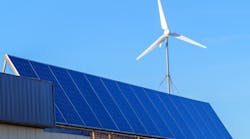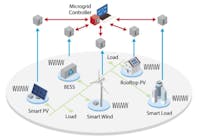The U.S. microgrid market is expected to grow 19 percent annually through 2027, according to Wood Mackenzie. That’s because microgrids provide enormous benefits for users, such as reliability, resiliency, and security.
A paradigm shift toward the adoption of high-performance electrical systems combined with the continuous deployment of smart home solutions will help foster industry dynamics. High conversion efficiency, low-cost converter systems, and improved power supply reliability in remote communities in conjunction with convenient systems for controllability, will boost the business expansion. However, increasing self-sufficiency across remote areas and rising integration of renewable energy technologies will inevitably propel the market.
With the expected growth and the world of energy changing rapidly, the microgrid market is finally ready for the next growth leader to keep power flowing and in balance - capitalizing on grid edge innovation: utilities.
Essentially only offering back-up power solutions for the larger utility grid, early distributed energy resources (DER) technologies were notably on the customers’ side of the meter. Now, the tide is turning toward traditional energy companies leveraging the benefits of microgrids and energy storage as key to enabling a more sustainable and resilient energy future.
It’s estimated that utility and municipality microgrid ownership will almost triple over the next two years (2023-2025). Despite the limited growth of municipality-owned microgrids, some municipalities are opting to share the ownership with the utility or local communities. Utilities are best positioned to deploy DER assets that are strategically integrated into the existing grid and the long-term network system upgrades in a manner that addresses the technical complexities of grid planning and sets everyone up for the lowest long-term cost and management of their energy. By combining the innovation of digital energy with a sound financial strategy, utilities can address the primary unmet need of today’s microgrid market in North America - the desire for new residential communities to have a more sustainable and resilient energy system that can be deployed, maintained, and operated by their trusted host utility.
DER assets are also a solution to bring energy justice to underserved and minority communities that may not otherwise have the resources for rooftop solar, battery storage or EV charging networks. Microgrids based on these distributed technologies are being installed today at college campuses, commercial and industrial facilities, military bases and even single-family communities. With policy innovation to prioritize the deployment of public funds for microgrids, more equity concerns could be addressed.Power surety is critical – especially as extreme weather and climate threats continue to worsen. In 2021, there were twenty (20) separate billion-dollar weather and climate disasters. The time for power surety delivered direct to homeowners has come into full focus. The home has become a hybrid work location for almost half of the workforce – demanding a higher amount of energy utilized at the home and a rising number of in-home medical machines for 55+ communities have added to the call for higher energy surety at home. In May 2022, BlockEnergy partnered with Metro Development and Lennar to develop a 37-home residential, renewable energy-based microgrid community, Medley at Southshore Bay in Tampa, FL. Working with Tampa Electric (TECO) to own and operate the sustainable power system, BlockEnergy has proven reliable in its first residential community, even during unpredictable weather events. While Hurricane Ian caused 1.1 million power outages across the Tampa Bay area, Medley at Southshore never lost their supply.
The historical beauty of a microgrid is the customization available to meet the precise resiliency, economic and environmental goals of any consumer. Each has been a personalized energy system of any size, made up of any available distributed energy resources (DER). Although this ability to customize is a microgrid’s strongest selling point, the downsides include time and money.
An alternative, fast-modeling approach, is to provide modular community microgrid designs that are inherently more scalable, thereby shrinking design and deployment costs and providing ease of repeatability. This approach is more attractive to financiers, as it creates portfolios of many similar assets, but this modular technology is only part of the solution.
The key to unlocking this technology for a more efficient integration of sustainable energy resources and enhanced resiliency for our energy future is direct current (DC). Our buildings are increasingly becoming DC-centric with LED lighting, electric vehicles, rooftop solar, batteries, and a growing number of appliances. With power outages increasing due to global climate change, extreme weather and increased penetration of DC energy resources not being integrated into the grid intelligently, the question begging for an answer is: How can utilities work with customers, regulators, and government to support the highest levels of clean, reliable energy deployment at the lowest possible total ownership cost for everyone?
The entire world is developing or already developed plans to get to net-zero carbon emissions, but it is abundantly clear that these goals will not be reached without utilities. If utilities take responsibility for the deployment of DER systems that can evolve into microgrids or related concepts, it can result in:- a technology agnostic platform that can foster a step-change increase in sustainable energy resources,
- advanced reliability and security across all stakeholders due to ownership and design structure,
- distributed digital platforms that are adaptable and can accommodate future load growth (and corresponding need for generation and energy storage). This allows for organic and evolutionary growth of the system without losing any functionality or an increase in emissions.
Microgrids provide a combination of benefits and cost avoidance for a more cost-effective alternative to serve new customers at the grid edge. If utilized as direct current, can be designed as no burden to the grid but can provide support to the grid, as needed. This is where flexible microgrids can provide added resiliency, when needed, but also support communities and the larger grid network if needed.
Utilities can and should take the lead in the march toward a new energy model focused on balancing decarbonization, resiliency, cost to serve, and equity stakeholder goals. Meeting all these objectives is not easy, but there are existing and advancing technological solutions that offer promising answers to the challenges facing an energy system undergoing rapid and transformative change. Answers that utilities are in the best position to tackle.
Bobbi Dillow-Walsh is Vice President, Sales & Commercial Development, BlockEnergy. As Vice Present of Sales & Commercial Development, Bobbi Dillow-Walsh leads the go-to-market strategy and execution to enable decentralized clean energy production and consumption for our transitioning energy market with regard to new residential energy development models and regulatory framework. With more than 20 years in the energy sector, her global perspective and entrepreneurial spirit has led Dillow-Walsh to be recognized for her work with many first-of-their-kind projects and solutions designed for resilient and sustainable energy. She leads with a focus on creating strong partnerships and collaboration that deliver economic value and advance safe, clean energy. Dillow-Walsh is a graduate of the Virginia Tech Pamplin College of Business and has an MBA from King University.



